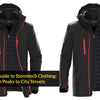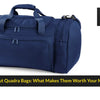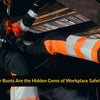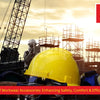What PPE should be worn on a building site?
- by Mike Johnson
What PPE should be worn on site?
A construction site is a highly hazardous environment. It’s a place where workers are at risk of coming into contact with toxic substances, heavy equipment, and large volumes of raw materials. Many sharp objects, slippery surfaces, and hidden dangers lurking around every corner. Wearing the correct PPE is essential for anyone who works on a construction site. This article will explain what PPE should be worn on a building site and why.Why is PPE so important on a construction site?
The International Labour Organisation (ILO) estimates that at least 60 000 fatal accidents occur each year on construction sites around the world, representing one fatal accident every 10 minutes. Accidents could be easily avoided if workers were wearing the correct PPE. However, many construction workers don’t take the importance of PPE seriously. They think PPE is restrictive and uncomfortable, so they don’t wear it. This is a huge mistake and can have tragic consequences. Construction workers are often exposed to toxic materials such as fumes, dust, and gases. Not wearing the correct PPE can result in serious health issues such as cancers, respiratory diseases, and skin infections. Wearing the correct PPE is essential to prevent these types of illnesses.
Respiratory Protective Equipment (PPE)
Respiratory PPE is designed to protect workers from toxic fumes, gases, and dust. Respiratory PPE should be worn by anyone who is exposed to these hazards regularly or in large amounts. Respiratory PPE includes:
Dust Mask
A dust mask is a simple piece of PPE that can prevent toxins from entering your body. A dust mask can also protect you from other harmful substances, such as mould spores, small insects, and allergens. Dust masks are made from a thin fabric that is designed to trap small particles and keep them from entering your respiratory tract.
Respiratory Hood
A respiratory hood is designed to protect the head, neck, and face. Respiratory hoods are often used in combination with dust masks. They are particularly useful when working with heavy equipment that creates lots of dust or toxic fumes.Eye Protection
Eye protection should consistently be worn when working near any hazardous materials. This includes any type of dust, chemicals, and heavy equipment. Eye protection is designed to protect your eyes against injury and contamination. There are different types of eye protection that you can wear on a construction site. It will depend on the type of hazard you are exposed to and the type of task that you are performing.
The most typical types of eye protection:
Goggles:
Goggles are a very common type of eye protection. They come in a wide range of styles and designs. In addition, goggles are often used in combination with other types of eye protection.
Safety Glasses:
Safety glasses are made from a special type of plastic to protect your eyes from chemicals and other hazards. They are often used in combination with ear protection.
Safety Boots
Safety boots should be worn when working outside on uneven and slippery surfaces. They are usually used with additional PPE, such as gloves, knee pads, and a hard hat. Here are some of the typical types of safety boots used on construction sites:
Safety Toe Boots
Safety toe boots are designed to protect your toes from getting crushed. They are often used in combination with other types of safety boots. They are a popular choice among construction workers.
Steel Toe Boots
Steel-toe boots are designed to protect your toes from falling objects, heavy equipment, and large volumes of raw materials. It’s important to wear steel-toe boots when working with heavy equipment. They are usually utilised in combination with other types of safety boots.
Heavy-duty work boots
Heavy-duty work boots protect your feet while working with large volumes of raw materials. They are frequently utilised in combination with other types of safety boots. They are durable and can withstand the harsh conditions of the construction site. Here are some of the most common types of heavy-duty work boots:
Oil-resistant boots
Oil-resistant boots are designed to protect your feet against liquids such as oil, chemicals, and other liquids used on the construction site. These types of boots are often used in combination with other types of heavy-duty work boots.
Rubber boots
Rubber boots are often used in combination with other heavy-duty work boots. They are suitable for indoor and outdoor use and come in various styles, colours, and designs.
Gloves
Gloves should be worn when working with heavy materials, chemicals, and other hazardous substances. Gloves come in a wide range of styles and designs. Depending on the task you are performing, you will need to wear the correct type of glove. Here are some of the most common types of gloves used on construction sites:
Leather gloves
Leather gloves are designed to protect your hands against sharp objects, chemicals, and extreme weather conditions. They are often used in combination with other types of gloves.
Chemical-resistant gloves
Chemical resistant gloves protect your hands against chemicals, solvents, and other hazardous substances. They are often used in combination with other types of gloves.
Conclusion - What PPE should be worn on a building site?
Construction work can be extremely dangerous if you don’t take the time to ensure that you wear the correct PPE. Wearing the correct PPE will protect you from hazards on a construction site and prevent many accidents. It’s important to select the correct type of PPE based on the hazards you are exposed to. It’s important to keep in mind that wearing PPE doesn’t mean you are invincible. You still need to exercise extreme caution on the construction site.
Active Work Wear are here to help you with any questions regarding Work Wear you need, just give us a call:0113 256 7021 or email on: info@workwearshop.co.uk
- Posted in:
- personal protection equipmant
- PPE






